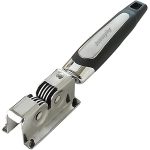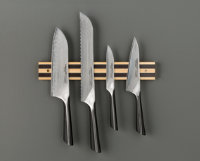
Should you treat your kitchen knives as beloved pets? Yes. These are valued tools in the kitchen and the better you take care of them, the better they will take care of you.
Although it may seem counter-intuitive, a sharp knife is much safer than a dull one. The reason for this is that a sharp knife does the work with relatively little effort on your part. But a dull knife causes us to press harder, which lessens control and may cause slipping. That leads to cuts.
Every cook has cut his/her hands at one time or another. But a sharp knife, used correctly with minimum effort, will leave a clean, probably shallow cut that will heal easily. But a dull knife under greater pressure can leave behind a ragged, deep cut that could cause some serious damage.
But Not For Ceramic Knives
By the way, all that follows applies to steel knives. Japanese ceramic knives are completely different and will have to be shipped back to the manufacturer for sharpening, which probably won’t be needed. Ceramic knives tend to hold their edge for a very long time. However, care should still be taken to protect that edge and keep it safely out of young hands without supervision. Remember these are ceramic and can break if dropped or dropped on.
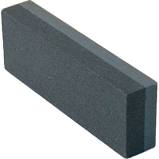
You need to keep all knives sharp. And that means a proper sharpening stone. They are not expensive and easy to use, but they take a little time and can be hard to find these days. Don’t look in the kitchenware section of your department store, go to a hardware store, preferably an old-fashioned kind if you can find one.
You might be tempted to buy one of those electric knife sharpeners. Sadly, none do a very good job. They tend to create a broad edge that dulls quite quickly, requiring you to sharpen the knife often, which wears away the metal. Also, they take way too much metal. That means your knives, which you spent so much money on, won’t last as long as they could or should.
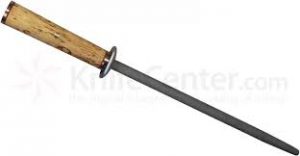
You might also believe that the honing steel, that long steel bar on a handle, sharpens the blade, but it doesn’t. It just trues the edge, which gets slightly bent with use. That doesn’t mean you should ignore the steel. Run your knife on the steel every time you take it out of the block. This keeps the edge sharp and reduces the frequency of real sharpening.
Don’t Be A Block Head
In addition to using a honing steel, you should store your knives properly by using a block or a magnetic strip. These protect the edge. Avoid storing knives in drawers where they connect with other metal tools. Always wash your good knives by hand, never in the dishwasher. Wash them as soon as you’re finished using them, don’t leave them laying around or in the sink. Not only is this safer, but it keeps acids from staining or corroding the metal, or food from sticking to the blade requiring more dangerous scrubbing to clean.
Avoid using a hand-held metal sharpener. They don’t do a good job at all and can actually damage your blade. Those are only good for gardening tools.
A sharpening stone should be what’s called a whetstone, meaning it uses water to create the abrasive that does the work. There are also oil stones, but they require the purchase of special oil and are hard to clean. The stone should be about two inches wide and five or six inches long. It should have two sides, a rougher side, and a smooth side. It should be stored wrapped in a soft, clean towel or rag in a place where it won’t be dropped or dropped on by hard objects, which could break it.
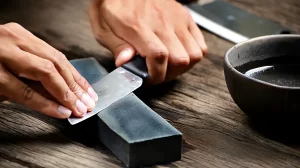
To use the stone, add a few drops of water to the rougher side of the stone. Holding the knife securely, tilt it up slightly (about 5 to 10 degrees depending on the size and original grind of the blade) with the edge down and move the blade in a small circular motion. This will work up a small amount of grit paste on the stone. For smaller blades this is all you need to do, remembering to repeat the process on the other side of the blade.
For larger blades, like a chef’s knife, wet the whole length of the stone. Run the blade along the stone in a manner similar to that used on a honing steel. The blade should be at about a ten-degree angle to the stone, edge down. Starting at the tip, push the blade, edge first, across the stone, almost like you’re shaving it. As you push the blade forward, also move it toward the handle. The motion will be on a diagonal. Repeat on the other side, switching sides every few passes. Always keep the edge of the blade pointed away from you.
How many times you do this motion will depend on how dull the knife is. When you feel it is sharp, turn the stone over. Wipe the grit from the blade and use the same motion for this side for 12 to 20 passes, alternating sides of the blade. This refines the edge. Wash the knife before putting it away.
This whole procedure will need to be done about every one to two years, depending on usage. It should also be done if you damage the blade or blunt the edge. Keeping your tools in the best shape will make cooking easier and more fun. The knife will do the work for you.
